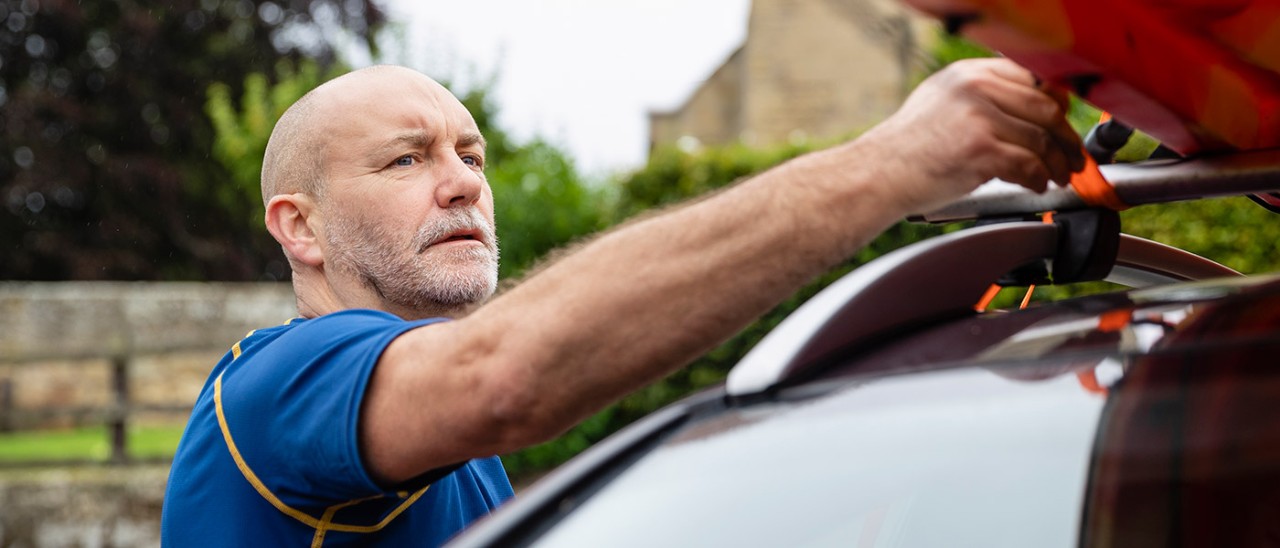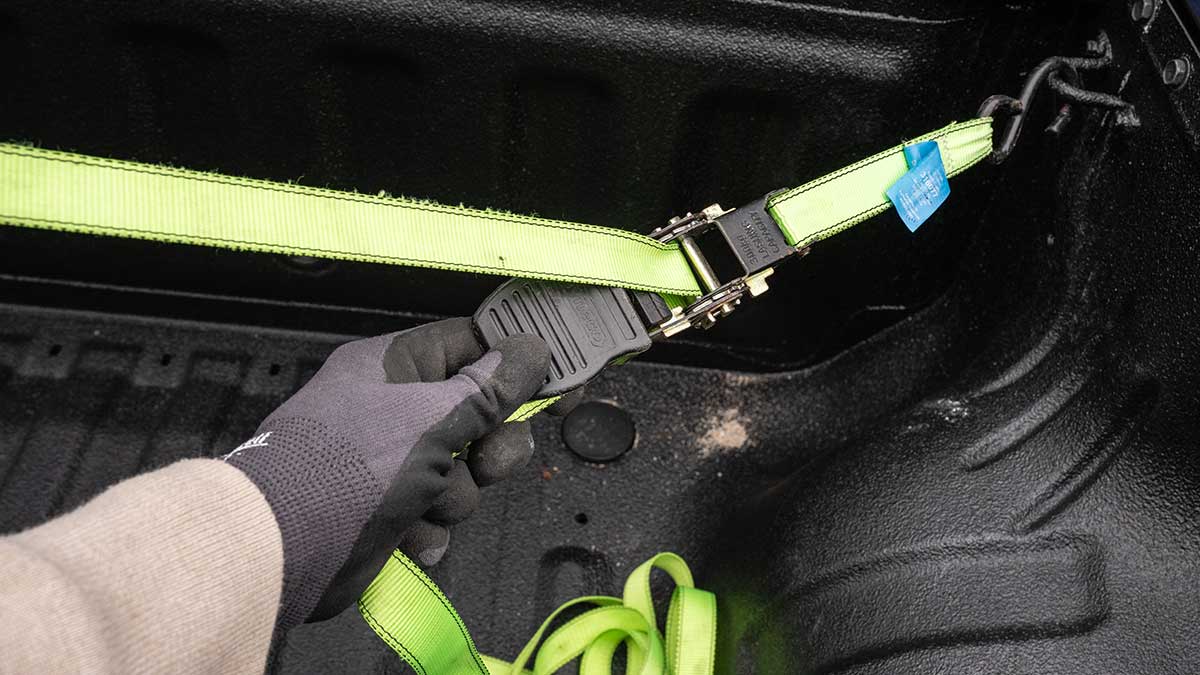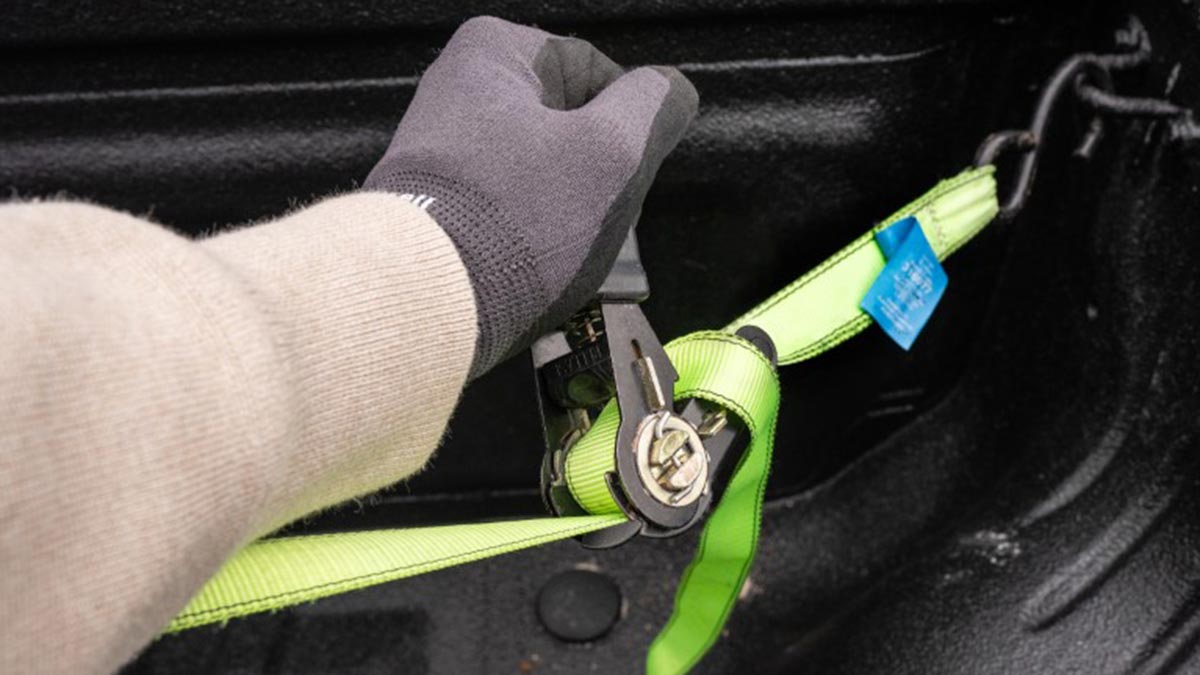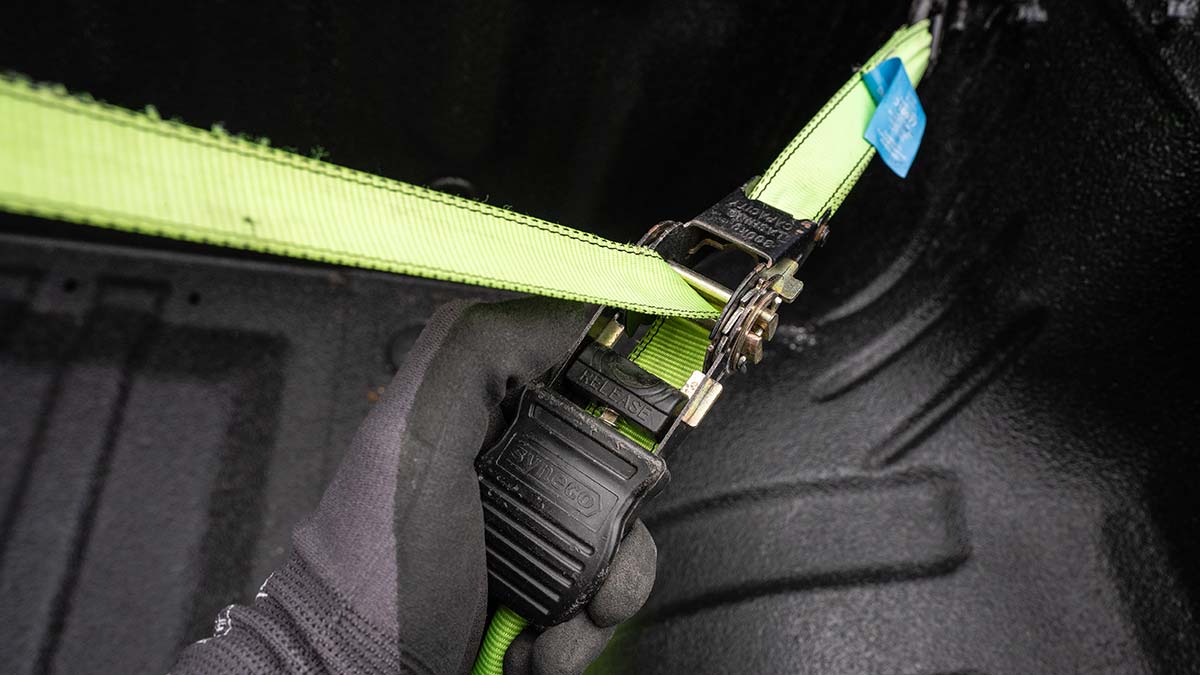Car steering wheel locks can help deter thieves and provide an extra layer of security. Here’s how to choose the best steering lock for your vehicle.
How to use a ratchet strap to secure a load

If you're carrying a load on your roof rack or in the back of your ute, it's critical that it's secure for the safety of all road users and to ensure your cargo arrives intact at your destination. Learn how to correctly and safely secure loads with a ratchet strap.
Whether you're moving house, transporting goods or lugging your camping gear out for the weekend, you'll often need a secure method of strapping down your cargo.
Ratchet straps, sometimes called tie-downs, are fasteners that excel at load and cargo restraint. Here's how to correctly secure your loads with a ratchet strap, plus how to safely release a ratchet strap. If you run into issues on the road and need assistance, RACV Emergency Roadside Assistance is available to help 24/7 all year round.
Remember to always set up your ratchet mechanism on the left side of your vehicle. This means that if you need to stop to check the load, you will have access on the verge side of the car away from traffic.
More: How to tow a caravan: a beginner's guide
More: The best cars to tow a caravan
Jump to:
Understanding vehicle load and weight limits
Choose your transport method
Decide how you’ll carry your load – in a ute tray, on roof racks, or in a trailer. Each option has different requirements, so plan ahead.
Pick the right vehicle
Ensure your vehicle is suitable for the load. Always check your owner’s manual for recommended weight limits and stick to them. Overloading can compromise stability and safety.
More: Search and compare cars, including 4x4 utes and the best cars for towing in Australia
Roof racks: Check your vehicle manufacturer’s guidelines for maximum roof weight. Refer to your owner’s manual or contact the manufacturer directly. Heading off-road? Roof load limits are usually lower, so confirm details with your vehicle manufacturer or roof rack supplier. Staying within limits keeps your trip safe and stress-free.
- Trailers: Be mindful of height and weight restrictions and how towing affects handling. For heavy items, make sure the trailer’s headboards and racks are strong enough to secure everything. When in doubt, check the owner’s manual.
Use proper restraints
Secure your load with the right equipment: webbing straps, ropes, chains, cargo nets or tarpaulins. Whenever possible, use rated equipment that shows its maximum lashing capacity. Webbing straps that meet Australian Standard AS/NZS 4380:2001 are recommended because they’re more effective and easier to use than ropes.
More: Trailer anti-theft devices and how to prevent trailer theft

Pull the strap through the ratchet mechanism until all the slack has gone.
How to use a ratchet strap
Step 1: Anchoring the strap
Start by attaching the ratchet end of the strap to a solid anchor point. This keeps the ratchet stable while you thread and tighten the strap.
- If you need to hold items together, wrap the ratchet strap around them and hook the two ends together. You will then need a second ratchet strap to secure the cargo in the vehicle.
- Protect sharp corners or abrasive surfaces with cardboard, blankets, or towels to prevent damage to both the strap and your cargo.
Step 2: Opening the ratchet
- Locate the release catch or lever: It is usually at the centre-top of the ratchet handle. Pull up or push in the lever to unlock the ratchet.
- Open fully: Flip the ratchet handle all the way open so the slot in the ratchet's mandrel is exposed and ready for threading.
Step 3: Feeding and positioning the strap
- Insert the strap: Take the free end of the strap and thread it through the slot, starting from the back and pulling it through toward the front. Make sure the strap lies flat and isn’t twisted.
- Attach free end: Hook the free end to the opposite anchor point on your vehicle or cargo.
- Wind and position the strap: Pull the strap through the ratchet mechanism until all the slack has gone. Close the lever so that the strap wraps around the axle inside the ratchet.
Step 4: Tightening the strap
- Crank the ratchet handle: Begin pumping the ratchet handle up and down. Each motion will pull the strap tighter around the load. The ratchet handle should click as you tighten.
- Remove slack and secure firmly: Keep ratcheting until the strap feels tight and your load is secure. Don’t over-tighten, as this can damage the strap or the cargo. Make sure that you can fit a finger between the ratchet strap and your cargo.
Step 5: Locking and securing the ratchet
- Close the ratchet completely: Once tight, press the ratchet handle down until it’s fully closed and flat. This locks the mechanism in place so the strap can’t loosen.
- Tidy up the excess strap: Wrap or tie off any extra strap length so it doesn’t flap while driving. You can tuck it under the strap or secure it with a Velcro tie.

Once all the slack has gone, use the ratchet to make the strap taut and then check to make sure your load is secure.
How to release a ratchet strap
Step 1: Open the lever
- A small lever or "release catch" is usually located on the main ratchet handle. This must be pulled up or pushed in before the handle can be fully opened to release the strap.
Step 2: Opening the ratchet completely
- While holding the release lever, open the ratchet handle all the way. This will release the tension on the strap. If the handle stops partway and the strap is still tight, push the handle forward slightly until you hear a ‘click’- this disengages the mechanism.
Step 3: Pulling the strap free
- Once the handle is fully open and the mandrel is unlocked, pull the loose end of the strap back through the slot to remove it.
Step 4: If the ratchet strap is jammed
- Ratchet straps can sometimes jam or get stuck, often because the ratchet hasn’t been fully opened and the gears remain locked. To release it, try pushing or pulling the release lever again while fully extending the handle until it lays flat. If the strap is tangled or jammed around the spool, you may need to manually loosen and unwind the strap to remove it. Avoid using excessive force, as this can damage the mechanism.

To release the strap, pull the lever or release tab all the way back to the fully open position until it clicks, then pull the strap out to create slack.
How to make sure your load is secure before you drive
It's important to ensure your vehicle's load is properly secured before you begin your journey. Be prepared for unexpected situations such as sudden braking.
- Inspect restraints: Check that all straps, ropes, or nets are properly tensioned and not frayed or damaged.
- Check for movement: Push on the load to ensure it is not shifting or sliding.
- Secure loose items: Make sure all loose parts of the load have been secured.
- Check anchor points: Verify that all anchor points, couplers, and latches are locked and secure.
- Ensure stability: Confirm the overall load is stable and will not cause the vehicle to be unsafe or difficult to drive.
Best places to stop to regularly check your load
If you have concerns about your cargo while driving, pull over and stop as soon as it's safe to do so. It is illegal to stop on a freeway unless it is an emergency, so regularly check restraints at safe locations along your journey to avoid dangerous situations. The best places to stop include:
- Public rest stops: These are designed for vehicle stops and provide ample space away from traffic.
- Large parking lots: Look for an open, flat space where you can pull over completely and work without obstructing other vehicles.
- Wide, straight shoulders: Choose a section of road where the shoulder is wide and level, with good visibility for at least 150m in both directions.
- Avoid curves, hill and intersections: Do not stop on curves, hills, or near intersections where visibility is limited for yourself and other drivers.
How to store a ratchet strap
Keep your ratchet straps in their locked position during storage. Check for any tears, elongations or deformations along the straps, levers and the ratchet itself before storing.
Don't leave your ratchet straps out in the elements: UV rays, rain and snow can damage the mechanisms and fabric straps.
Some straps will come with their own storage bag, while others may have a Velcro strap to prevent uncoiling. Store your ratchet straps individually in bags or keep them coiled with a Velcro strap or rubber band before storing them in your vehicle compartment or garage.
What type of ratchet strap do you need?
Ratchet straps come in different widths, lengths, end fittings and weight capacities. Weigh and measure your cargo and look at your vehicle's anchor points to determine which ratchet strap is best for your needs.
It's important to note that ratchet straps are rated for their working load limit (WLL), which refers to the weight of cargo that they can hold. It's better to use a stronger strap that you think you need: wind, acceleration and braking can make your cargo weigh more than it does on the ground.


